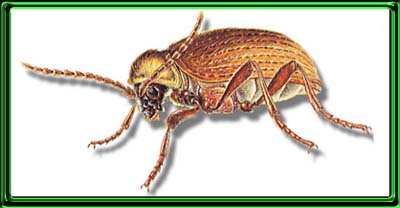
(Australian Spider Beetle)
This species arrived in Europe and the UK from Australia as recently as 1900, but it now common more or less everywhere.Spider beetles are general scavengers. They feed on a variety of items, such as cereals, seeds, flour, meat, dried fruits and vegetables, fish food, dead insects, rodent droppings, old wood, cayenne pepper, roots, cocoa, sugar, drugs, and spices. Common sites of infestation in the house include wall voids and drop ceilings, as the infestation usually originates in a birds nest. Spider beetles are primarily warehouse pests, attacking various seeds and certain whole grains, such as wheat, barley, rye, and flax, they can also destroy insect collections and damage stuffed animals. Also, serious infestations have been found in flour and feeds, such as bran shorts and meal preparations. Larvae cause a typical "scarring" of the wood in buildings in the formation of pupal cells prior to pupation. Spider beetles sometimes become prominent cereal pests in Canada and the northern United States. Some have been found quite active even during freezing weather. They do not bite or sting humans or pets, spread diseases, or feed on or damage the house or furniture, but are a very common pest in the home.
Identification:
Adult spider beetles are minute oval or cylindrical insects with long legs resembling giant mites or small spiders. The head is often hidden when viewed from above. They are 1/16 to 3/16 inch long with long filamentous antennae (usually 11 segmented) arising on the front of the head close together at the base. Most are brownish-black with a large, globe-like abdomen and the prothorax (first segment behind the head) constricted at the base of the wing covers. Larvae are C-shaped or grub-like and cream-coloured with short legs. The segmented abdomen contains many long hairs.
Life Cycle and Habits:
The female lays about 100 opalescent, sticky eggs, singly or in small groups, over a period of 3 to 4 weeks. Food and debris adhere to the eggs. The fleshy larva (which can grow up to 1/8 inch long), covered with fine hairs, is strongly curved, cream coloured and rolls up into a tight ball when disturbed. It can chew its way through sacking, cellophane, or cardboard, and can hollow out a chamber in adjacent woodwork when making a place in which to pupate. Pupation takes place in a tough, spherical, thin-walled cocoon. The adult may remain in this cocoon as long as 3 weeks after emergence (Hickin, 1964). Howe (1943) found that at 21°C (70°F) and 70% relative humidity, the eggs hatched in 8.6 days; the 3 larval instars required 59.9 days; the pupal stage, 15.9 days; the pre-emergence period (adult in cocoon), 9.5 days; and the total life cycle, from egg to the adult leaving the cocoon, 93.9 days.
Larvae often bore into wood or cardboard boxes to overwinter in the pupal cell with actual pupation occurring the following spring. Some spider beetles can remain active during the cold months, especially in older buildings where sources of food have accumulated. Spider beetles may become pests in homes, warehouses, grain mills, museums, etc. They are attracted to moisture, excrement, and abandoned animal nests.
To treat a roof space the easiest way is with smoke generators (see the Cluster Fly Page). To treat the rest of the house, if these little beasties have come down out of the roof space, a regular spray treatment should be carried out to wall/floor junctions with a residual insecticide over a period of about three months. Remember, spray kills the adults and the larvae but it doesn't kill the egg or the pupae, so the treatment has to be carried out over a period of time so that it gives the aggs and pupae a chance to become larvae or adults and thus be susceptible to the spray.